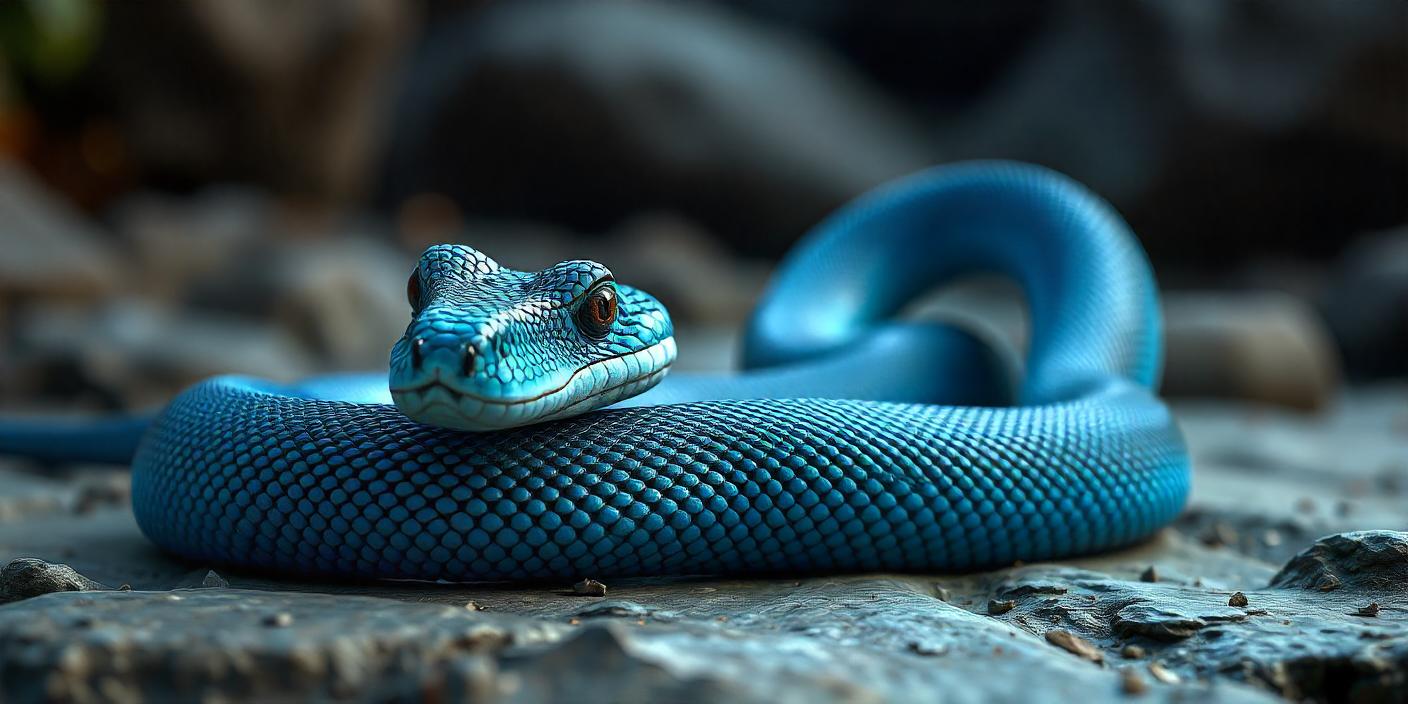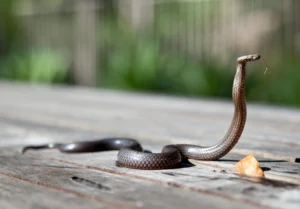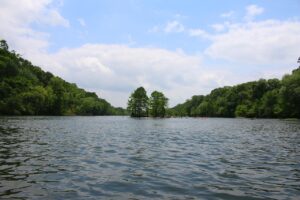The Poisonous Blue Snake

The poisonous blue snake is a remarkable and fascinating reptile, unique for its bright blue coloration.
Found on the islands of Ternate and Tidore in eastern Indonesia, this species is a member of the venomous blue snakes that belong to the genus Lytico.
Little is known about their behavior, but they are primarily nocturnal, and their diet consists of frogs, lizards, and other small snakes.
These snakes grow up to 670 mm long and are slender in build. Their head is flat and wider than the neck, and they have large eyes situated more on the top of the head than on the side.
The body is covered in smooth, shiny, and non-keeled scales. The coloration of adult individuals is brilliant blue or greenish blue with a lavender sublabial.
The suture between the frontal and prefrontal scales is longer than the length of the frontal, and scales along the middorsal region count 35.
These snakes are completely harmless to humans, despite being mistaken for the deadly blue snakes of the genera Rhabdophis and Hydrophis that are found in Sumatra and Java.
Blue snakes are not aggressive. When threatened, they curl up in a loose coil and flatten the head, exposing the barcode-like patterns on the scales.
They then lie still to avoid detection. If captured, blue snakes strike rapidly but do not bite nor latch on to the prey. Instead, they wrap around it, forming a figure-8 shape.
The high interstitial fluid of blue snakes’ tissues, including the skin, aids in wrapping. Blue snakes constrict slowly, persisting for many minutes, and then move away after sensing no further movement from the prey. With a low heart rate of around 30 beats per minute, blue snakes are capable of spending hours constricting before the prey is evoked.
Physical Characteristics
Blue snakes are the most toxic snakes in the world, as their venom is classified as neurotoxic. When the neurotoxic venom flows into the blood of a victim, it blocks neurotransmission at the motor end plate by binding to the nicotinic acetylcholine receptor (nAChR) there.
As a result, skeletal muscles are paralyzed over a short time period. If the respiratory muscles are paralyzed, the victim will die from asphyxiation within 1-2 hours. However, there are still some slow-acting blue snakes, such as the dragon blue snake, hybrid blue snake, and svakona blue snake.
These blue snakes have venoms that are both neurotoxic and cytotoxic, so it may take up to 1-2 days before victims succumb to death. All snakes have front fangs that can only inject venom into victims.
In terms of size, the blue snake is the largest poisonous snake in the world, as it can reach lengths of over 10 feet. It is also known to be able to capture large mammal prey weighing over 200 kg. The body is laterally compressed, and the head is also flattened. Hence, it can stay submerged in water to hunt for prey. The body and neck are covered in large blue scales.
The poisonous blue snake is also the second fastest snake in the world, as it can swim up to 20 km/h. The species does not have any eyelids, but instead has a transparent vision shield protecting one of the five senses.
Habitat and Distribution
Currently, two species of the poisonous blue snake, both of the genus Acrolophis, are known. Acrolophis histrio is found in the Antillean islands of Hispaniola and Jamaica.
Acrolophis rutilans is found only in Cuba, the forests of the Cienaga de Zapata being a well-known locality for this snake. A. rutilans was studied there starting from 1941.
A better description of this snake became possible as the laboratory colony developed and later additional specimens (both live and preserved) were obtained. The present study is based on living snakes of A. rutilans, which culminated in 1941–43, and it is hoped that the data presented will give a better understanding of the biology of this interesting reptile.
The poisonous blue snake, a member of the colubrid subfamily of the family snakes, is a non-ventilating, non-viperine snake of Cuba, the Cayman Islands and Jamaica islands of the Greater Antilles.
The blue snake, known in Cuba as the “Blue Snake of the Beast,” has translucent bluish skin which is splendid, magnificent and beautiful, among the most wonderful colored groups of the serpents.
Among the visible tropical snakes, this species stands apart in being a nervous, agile and readily irritable snake. Frequenting curving trunks and limbs of trees, it hunts down small lizards in the green forests of Cuba. It also hunts down the lesser forms of reptiles, besides some field mice.
It has glands and fangs capable of inflicting a bite on prey. The bite of this serpentine beast is venomous, poisonous for the lizards but not for larger animals like chickens and animals of size equal to that of the snake, more than 55 cm. A 7 cm lizard (Anolis) turns into an unconscious thing in two minutes after affliction of the bite. But this
Mating Behavior of the Poisonous Blue Snake
This genus of poisonous blue snakes provides an unusual opportunity to observe reptile mating behavior, thanks to its striking color. Mating behavior differs tremendously among reptilian species, partly dependent on body color.
While some poisonous blue snakes have body color similarity to their surroundings, which aids in passive camouflage, others have the most remarkable body color that stands out against their surroundings. These creatures are brightly colored, resembling the deadliest frogs and fish found on the island of New Guinea.
Nevertheless, captive observation of some poisonous blue snakes demonstrated that this remarkable color also plays an important role in mating behavior. Males and females discerned by their coloration and dorsal patterns showed courtship, copulation, and post-courtship behaviors.




